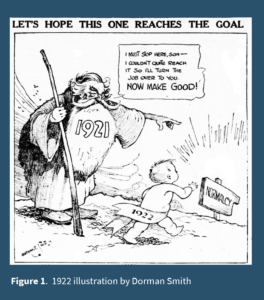The following is an excerpt from the quarterly newsletter distributed to clients.
Rewarding 2021 – Prospects for 2022
Stock markets posted strong returns during the fourth quarter, capping off a very good 2021 for most investment assets. Globally, the S&P500 once again led the way in Q4, gaining 11%, while in Canada, the S&P/TSX rose 6.5%. Meanwhile, bond markets performed well despite the prospect of higher interest rates as central banks signaled their intentions to cool inflation.
The big story during the quarter, however, was the emergence of the highly transmissible Omicron variant in November, which caused substantial volatility and a shift beneath the surface of the strong index numbers. As a result, economically sensitive areas suffered while investors embraced the perceived safety of large technology and growth stocks.
The quarter ended on an encouraging note, however, as it became apparent from South African and UK data that despite Omicron’s increased transmissibility, the variant was clearly causing significantly fewer severe outcomes. The news bodes well for 2022, as it signals the potential for the long-awaited transition of COVID from pandemic to endemic. A “return to normalcy” would benefit investments that have been depressed due to COVID.
For the year, Focus’ investment strategies posted strong results; our best-ever, in fact. And we believe that 2022 will also provide a favourable backdrop for active, value-conscious managers like ourselves. While markets generally appear “fully valued,” changing narratives and bouts of volatility in 2021 allowed us to re-position our portfolios into attractive opportunities—securities that the market was ignoring or mis-valuing. This, coupled with our generally positive view of the North American economy, makes us optimistic we can deliver strong results for our clients.
Going into 2022, we have placed an emphasis on investments that:
- are high quality and trading at attractive valuations
- will benefit from an improving economic landscape
- have abilities to weather higher interest rates and inflation.
No investment letter is complete without a few words on COVID, however perfunctory. Markets have long since put COVID in the rearview mirror. Perhaps 2022 is the year COVID fades into the background in all respects. We can only hope. Although the influenza pandemic of 1918 is now viewed as having been extremely nasty but relatively short, the New Year’s cartoon (see Figure 1) from exactly 100 years ago is interesting in that it portrays 1922 as the year that “normalcy” was finally set to return.
Investment Strategies
Equities
It was an interesting year for equity markets in 2021. With few exceptions, our portfolio companies delivered impressive operational performance, reinforcing our conviction in the businesses we own and the management teams that run them. For most of the year, these positive financial results generated commensurate upward moves in share prices. However, during the fourth quarter, a wave of negative sentiment swept over the markets and included the following concerns:
- changing policy by US Federal Reserve
- the Omicron COVID variant
- lingering supply chain issues
- the outlook for inflation
These issues caused many traders to sell all but the largest market capitalization companies in a “flight to safety” towards large (and very expensive) technology and growth stocks. Given the significant weight of these stocks in the indexes, this move masked what was a particularly difficult time for most of the market, including some of our holdings. As our conviction levels remain high, the prospective risk-reward for these investments improved. We thus used the opportunity to increase exposure to our favourite ideas.
It may sound odd after a strong year and with markets near all-time highs, but we are as excited about our portfolio as we have been in some time. The bedrock of the fund is a compilation of high-quality mid-sized companies with solid organic growth, high margins, strong free cash flow, a healthy financial position and smart capital allocators at the helm, trading at attractive valuations (in most cases, a discount to the market multiple). We’ve supplemented these positions with a smaller number of companies that offer even higher potential returns given what we view to be a dramatic mispricing for idiosyncratic reasons.
Portfolio turnover in 2021 was somewhat higher than it has been historically. The primary driver of this was the exceptional performance of certain stocks we acquired near the depths of the COVID market sell-off in Spring 2020. As discussed at the time, we felt the market was providing a rare opportunity to buy some of the world’s best businesses (Home Depot, Nike, Mastercard) at reasonable prices and we took full advantage. At the time we bought them, we felt these stocks had the potential to double in 3-5 years (an incredibly compelling return profile given the size and quality of the businesses). It ended up happening in 9-12 months! As much as we like these businesses, the stocks went right back to the prohibitively expensive pre-COVID valuations, leaving them with what we project will be underwhelming future returns. As a result, we made the decision to sell and redeploy the capital into investments with better prospects. The benefit of this “re-positioning” is that despite the strong fund returns in 2021, the prospective five-year returns on our portfolio remain quite compelling.
An important theme for 2022 is the following: broad markets look unattractive because they are dominated by the shares of massive companies that:
- are expensive from a valuation perspective
- may show decelerating earnings growth as COVID recedes.
As such, and in order to generate attractive returns going forward, our portfolios will look very different from the market.
Fixed Income
Fixed Income has avoided losses in the bond market, but the time may be coming to slowly and cautiously add yield to the portfolio.
For some time, we have communicated our commitment to keeping the fund defensively positioned in a rising rate environment until we see a better risk/reward scenario in bond markets. This has meant very-short-duration bonds and hence the avoidance of losses as rates increased. Although the fund will always remain the most conservative strategy that we manage at Focus, we are slowly starting to see better opportunities to add yield to the portfolio. The reason for this is that markets have now priced in multiple interest rate increases from the Bank of Canada in the coming quarters, which may or may not materialize.
Credit Opportunities
Credit Opportunities seeks higher returns for clients’ fixed income exposure by investing in various types of bonds, mostly corporate credit or debt. Even after strong returns over the last two years, Credit Opportunities is still positioned with a meaningful yield and attractive upside potential – in a diversified and conservatively-minded mandate.
Private Investment Funds
The private funds give clients access to investments not publicly traded like traditional stocks and bonds. As the majority of the investing public does not have access to private markets, returns can be superior to public markets. And since private assets do not trade on an exchange, they have less volatility. These aspects serve to enhance portfolios over the long term.
- Focus Private Debt
We continue to pursue potential opportunities in the alternative lending space including trade finance, music royalties, heavy asset (railcar, aircraft) leasing and infrastructure debt. Our focus remains on secured, shorter-maturity debt with floating interest rates, which we expect will deliver higher and more consistent returns than traditional fixed income investments, without the interest rate sensitivity.
- Focus Infrastructure & Real Assets
We continue to look for opportunities in the real asset space including farmland, infrastructure and differentiated real estate. We are quite positive on real assets given the attractive long-term return profile, lower volatility and inflation protection they offer and would be happy to discuss why we think they likely make sense as part of your overall asset mix.
Closing Comments
Despite strong stock and credit markets performance during 2021, the recent Omicron and Delta waves have served to renew investor skepticism towards the economy and markets. For investors with a contrarian streak, this is encouraging as markets do best when “climbing a wall of worry.” The time to be most cautious in markets is when the economy is perceived to be booming and the investing public is fearlessly taking on risk.
To be clear, there are plenty of frothy areas of markets at the present time, and those areas should be avoided. However, large swaths of the public markets still offer attractive potential. To give an example of the level of bifurcation in the stock market at the present time, during the final week of December when the S&P500 closed at a 52-week high, 334 of the 500 companies in the index hit a 52-week low. This was more than double the number of companies trading at 52-week highs.
In terms of risks, higher interest rates do pose a challenge for public markets and this bears watching. However, some sectors and securities are more vulnerable than others. Government bonds do poorly as interest rates rise, as do highly-valued growth and technology stocks, as we have witnessed recently. Although we are not necessarily predicting much higher rates, we have structured our portfolios with that potential scenario in mind. It was also one consideration in the launch of our private funds, which are designed to deliver attractive and consistent returns in such an environment.
In the short term, however, an appreciable rise in rates would certainly cause volatility across markets, particularly stocks. As always, we remain focused on the long term. High-quality, long-term investments at reasonable valuations still looks like a prudent strategy.



